(47383 products available)








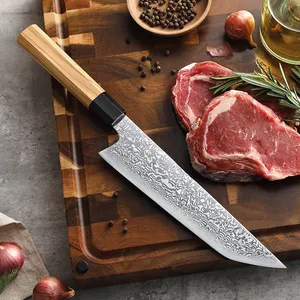























































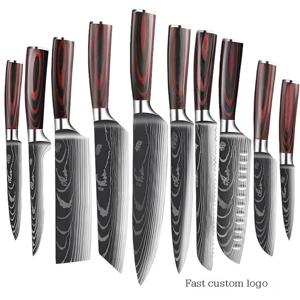
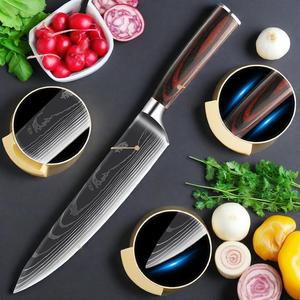

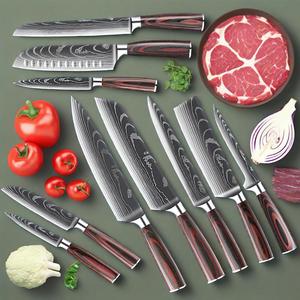
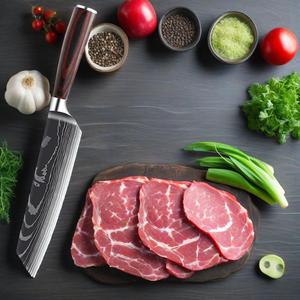





















































































































































Custom chef knives are made to order to meet the needs of a particular chef. They improve efficiency in the kitchen and give it a distinctive touch. There are many types of custom chef knives.
Personalization by design
Some custom chef knives are personalized based on design. The knife's shape and the way it looks to the eye are part of the personalization. The blade, handle, and other parts of the knife are designed to fit the user's tastes. For example, a user can select a certain blade curve. They can add their logo or special markings to make it look unique. It will be a great fit for a restaurant or cooking school. It can also be a personal gift for an avid cook.
Material selection
The materials for the blade and handle of a custom knife can be selected. A user can choose high-carbon stainless steel for a durable and easy-to-maintain blade. They can opt for Damascus steel if they want a knife that looks visually stunning yet sharp. The handle can also be made from wood, metal, or synthetic materials. Each material has unique properties and appeal.
Blade customization
Blade customization is a popular type of custom chef knife. The blade can be altered in several ways. The length of the blade can be changed based on the intended use. Shorter blades are good for precision work, while longer blades are good for cutting through large items. The thickness of the blade can also be changed. Thicker blades are good for heavy-duty tasks, while thinner blades are good for delicate work. The blade can also have different edge profiles. They may include straight edges for slicing, curved edges for rocking, and serrated edges for cutting through items such as bread.
Handle customization
The handle of a custom chef knife can also be customized. The handle is an important part of the knife. It is what a user holds to carry out cutting tasks. Handles can be made to fit the hand better and make cutting easier. They can be made from different materials, such as wood, metal, or plastic. The handle can be designed to have a better grip, be more comfortable, and look nicer. The handle can also have custom features like finger grooves, bolsters, and pommels.
Materials
Custom knives utilize materials that are of high quality and durable. The materials used in making the blades can be different types of steel, such as high-carbon steel, stainless steel, or a combination of both. High-carbon steel is known for its ability to hold an edge and be sharpened very sharp. Stainless steel is popular for its rust and corrosion resistance. There are also other materials used for the handles, such as wood, metal, or composites. Each material has unique properties that contribute to the overall performance and aesthetics of the knife.
Blade Design
The design of the blade is one of the most important aspects of a custom chef knife. The shape of the blade can vary depending on the type of cooking it is used for. For example, a chef's knife usually has a curved edge that allows for rocking motion cutting, while a paring knife has a more pointed tip for precise work. The length and width of the blade also affect its versatility and control. A longer blade can handle larger tasks, while a shorter one offers more control for delicate work.
Handle Design
The handle of a custom chef knife is as important as the blade. It must be comfortable and easy to grip to ensure proper use. Handles can be designed in many ways regarding shape, size, and material. Wooden handles offer a traditional look with good insulation properties. Metal handles are sleek and modern but can get cold. Composite handles are lightweight and durable, often available in various colors and textures. The design of the handle must fit the user's hand, with some curvature and thickness, providing balance and control.
Aesthetics
Custom knives can have many different looks, depending on the user's and the knife maker's preferences. The blade can be polished to a shine, have a patina, or feature custom engravings. The handle can also be personalized with different colors, materials, and embellishments such as pins, bolsters, and ferrules. These aesthetic elements not only make the knife look nice but also show the individuality of the chef who uses it.
Functionality
The knife's functionality is the most important aspect of its design. A custom chef knife must be able to cut, chop, and slice efficiently, with a blade that stays sharp for as long as possible. The weight and balance of the knife should allow for easy and controlled use. The blade's thickness and the curvature of its edge should be suitable for the tasks it is intended to perform. Overall, the design of a custom chef knife must prioritize functionality to meet the demands of professional cooking.
Custom kitchen knives have been purposefully designed for different scenarios and use cases. The following are some of the scenarios where custom-made kitchen knives are used:
Daily cooking
These knives are used for daily cooking activities, including chopping, slicing, dicing, and mincing vegetables, meat, and fish. They are suitable for all-around culinary tasks and provide the precision and control a cook needs.
Specialized culinary tasks
Custom-made chef knives can be created for specialized culinary tasks, such as filleting fish or carving meats. A custom knife designed for specific tasks will have the right shape and edge to handle the job well.
Presentation and plating
Aesthetically pleasing knives can be used for precise cuts during presentation and plating. These knives are designed to be sharp and are used to create clean cuts for garnishes, sauces, and food arrangement.
Artistic cooking techniques
Custom knives can be used for techniques like food carving, sushi making, or molecular gastronomy. Knives made for these techniques may have unique blades, such as a honesuki for butchering poultry or a nakiri for chopping vegetables.
Professional competitions
Custom chef knives are also used in culinary competitions. These knives are designed to give the competitor an advantage in speed, precision, and control, which can be crucial in a high-pressure, fast-paced contest.
Fieldwork and foraging
A custom chef knife designed for fieldwork can be used for foraging, field dressing, or preparing food outdoors. These knives may have features like a sturdy blade for working in the field.
Personal use
Some personal customizations are made to custom-made chef knives, such as adding a name or creating a unique design. This is to show ownership or identity. These knives are primarily used for personal cooking rather than professional use.
For business purposes, choosing the right custom chef knives is crucial for one's kitchen operations and can greatly impact the efficiency and satisfaction of the chefs. Here are some important factors to consider when selecting custom chef knives.
Purpose and Usage:
Clearly define the primary purposes and uses of the custom chef knives. Consider the types of cuisines being prepared, the cooking styles employed, and the specific tasks the knives will perform. For example, if one's business focuses on fine dining, a custom chef knife for precision and presentation may be necessary.
Chef Input:
Involve the chefs who will be using the knives in the selection process. Their expertise and preferences are invaluable. Consider their feedback on blade design, handle ergonomics, and overall performance. After all, the chefs know best what they need to excel in the kitchen.
Quality and Craftsmanship:
Choose custom chef knives that are well-made and of high quality. Look for knives made from durable materials, such as high-carbon stainless steel or Damascus steel, which offer excellent edge retention and ease of sharpening. Also, pay attention to the craftsmanship, including the fit and finish of the blade and handle.
Ergonomics and Safety:
Select knives with comfortable handles that reduce the risk of fatigue or injury. Consider features like slip-resistant handles and proper weight distribution. Knives should be easy to control and maneuver, allowing chefs to work efficiently and safely.
Budget and Longevity:
Consider the knives' cost and the value they provide. While custom chef knives can be expensive, investing in durable knives that will last and require less frequent replacement may be worth it. Also, consider the potential for customization to brand the knives to one's business.
Blade Design and Features:
Choose blades that suit the tasks and the knives' features. Consider factors like blade length, thickness, and shape. Also, think about features like full tang construction, bolster design, and custom engravings.
Q1. What are the benefits of a custom chef knife?
A1. The benefits are improved comfort, personalized design, and enhanced performance.
Q2. What is the custom knife-making process?
A2. It involves choosing the knife's style, selecting materials, personalizing features, and crafting.
Q3. What materials are used in custom chef knives?
A3. They include high-carbon steel, stainless steel, and various handle materials like wood or resin.
Q4. How can one choose the right custom chef knife?
A4. Consider the cooking style, preferred knife features, and ergonomics.
Q5. How can one care for a custom chef knife?
A5. Regularly sharpen the blade, hand wash it, and dry it immediately and wooden handles/oil knives.